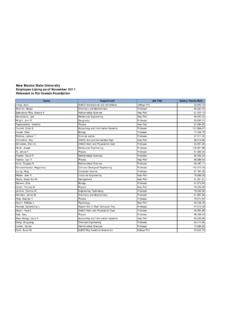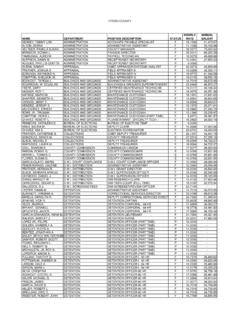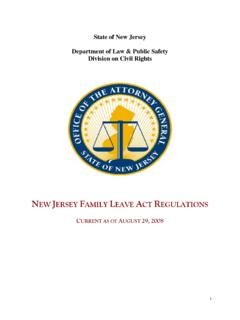Transcription of Public Sector Collective Bargaining: New Mexico Need Not ...
1 Rio Grande Foundation Liberty, Opportunity, Prosperity New Mexico Public Sector Collective Bargaining: New Mexico Need Not Follow California Into the Fiscal Abyss By Hal Stratton Former Attorney General of New Mexico , Chairman of the Consumer Products Safety Commission, and co-founder of the Rio Grande Foundation. Post Office Box 40336 Phone: (505) 264-6090. Albuquerque, New Mexico 87196 Fax: (505) 213-0300. Introduction The recent economic downturn and pressure placed on all government budgets has caused an examination of why and how state and local governments have accrued such high levels of sovereign debt. It has become clear that those in charge of running the government have no fiscal discipline when economic times are good and governmental coffers are flush.
2 The concept of saving for a rainy day is an alien idea when it comes to government. During good times there is pressure by various special interest groups to spend every penny taken in by government, and even more so by promising government entitlements without paying for them. Nevertheless, the recent debate about whether government employees should experience compensation freezes or reductions, like many have in the private Sector , should draw attention to yet an issue that has exacerbated if ultimately not caused most of the government fiscal problems. That issue is the practice known as Public Sector Collective bargaining along with related Public Sector union political activity.
3 In this paper I will discuss the subject of Public Sector Collective bargaining, how it evolved and the fiscal damage it has caused to our state and local governments particularly. I will review the history of Public Sector Collective bargaining in New Mexico and where we find ourselves in relation to Public Sector unionism and Collective bargaining. In New Mexico we have an opportunity, even after the binge spending over the last seven years by the state government, to put on the brakes and hopefully avoid putting our taxpayers and citizens in the dilemma that California, Illinois, New Jersey and others find themselves in today.
4 This can only be accomplished by avoiding the pitfalls that California has experienced where Public Sector unions have effectively taken over state and local governmental decision making through the process of Collective bargaining and political activity electing Public officials who are beholden to the Public Sector unions. What are Labor Unions and Collective Bargaining? Trade or labor unions are organizations of workers who have banded together to achieve common goals. Labor unions originated not in the classical world--Greece or Rome--but in Europe during the industrial revolution and are seen by some as successors to the guilds of medieval times.
5 Such medieval guilds were formed to limit the entry of individuals into various trades and thereby enhance the incomes of its members by limiting competition in the field. Originally, trade unions were outlawed by the Ordinance of Labourers adopted in England in 1349. and remained illegal until the beginning of the 19th Labor unions in the United States were originally created primarily to organize strikes, but, now, the real function of labor unions is to bargain collectively with its members' employers as to the terms and conditions of employment and to engage in political activity to enhance its members compensation and the union's political clout and influence.
6 Collective bargaining can be defined generally as a process designed to reach an agreement regarding terms and conditions of the employment between employees and employers. Collective bargaining aims to reach a Collective agreement which usually sets out issues such as employees pay, working hours, training, health and safety, and rights to participate in workplace or company affairs. 1. Collective bargaining between employers and employees in the private Sector was codified in the National Labor relations Act passed by Congress in However, Collective bargaining in the Public Sector , between the government and its employees, did not begin until much later.
7 Public Sector Unionism and Collective Bargaining Throughout American history -- and as recently as the 1950s -- there were no unions for government workers and no Collective bargaining between workers and their government Public Sector employees were expected to earn a bit less than their private Sector equivalents in return for job security, reasonable benefits and the privilege of working as a Public servant. The number of states allowing Collective bargaining for Public Sector workers jumped from one in 1955 to 10 in Then in 1958 New York City Mayor Robert Wagner in an appeal to city workers for votes, signed an executive order authorizing New York City workers to unionize, and soon other local and state legislators around the country began to follow his In 1962, President John F.
8 Kennedy granted federal employees the right to collectively bargain by signing Executive Order Since then, Public Sector union membership has increased significantly while, in the private Sector , union membership has fallen. And, in 2009, for the first time in the United States, Public Sector unions counted more members than unions in the private It is reported that today 26 states have Collective bargaining for all state and local workers, twelve states have Collective bargaining for a portion of their state and local workers and as of 2002, approximately 12 states have no Collective bargaining in the Public But, what effect do Public Sector unions really have on government?
9 And, isn't it fair to let government workers collectively bargain with their government employers the same way their counterparts do in the private Sector ? The simple answer is no. To illustrate the problem, we only need look to the California experience where runaway Public Sector unionism and Collective bargaining along with related political activity by Public Sector unions has put the state and many local government into a state of insolvency which is going to be difficult to Public Sector Unionism and the state of California In 1968 the California legislature passed the Meyers-Milias-Brown Act extending Collective bargaining rights to municipal, county, and local special district employers and The 2.
10 29 151-169 (1935). 3. See Henry S. Farber, Union Membership in the United States, Working Paper 503, Industrial relations Section, Princeton University, September 2005. 4. Farber (2005) at p. 5. 5. O'Neal, T., and McMahon, (2007) Taylor Made: The Cost and Consequences of New York's Public - Sector Labor Laws. Empire Center for New York State Policy (October). 6. 7. Greenhouse, Steven, Most Union Members are Working for the Government, NewData Shows, New York Times (January 23, 2010). 8. Government Accountability Office, Collective Bargaining Rights, September 2002, p. 8. 9. See generally, Malanga, Steven, The Beholden State: How Public - Sector unions broke California.











